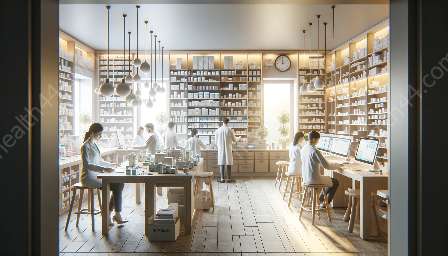The Importance of Multifunctional and Flexible Spaces in Restaurant Design and Layout
Restaurant design and layout play a crucial role in shaping the overall dining experience for customers. In recent years, the concept of multifunctional and flexible spaces has gained popularity among restaurant owners and designers. These versatile spaces are designed to serve multiple purposes, adapting to different needs and enhancing the overall functionality of the restaurant.
When considering the design and layout of a restaurant, it's essential to create spaces that can accommodate various activities without compromising the comfort and experience of the guests. Multifunctional and flexible spaces offer a practical solution to this challenge, allowing restaurants to optimize their floor plans and cater to diverse customer preferences.
Enhancing the Dining Experience
One of the key benefits of multifunctional and flexible spaces is their ability to enhance the dining experience for customers. By creating adaptable areas that can be easily transformed to accommodate different group sizes, events, or service styles, restaurants can offer a more personalized and enjoyable experience for their patrons.
For example, a restaurant with a flexible dining space can effortlessly transition from hosting intimate gatherings to accommodating larger groups for special events or celebrations. This adaptability not only adds value to the customers' experience but also allows the restaurant to maximize its revenue potential by catering to a wider range of dining preferences.
Maximizing Space Utilization
Effective space utilization is a critical factor in restaurant design, especially in urban areas where real estate can be limited and costly. Multifunctional and flexible spaces enable restaurants to make the most of their available square footage by seamlessly adjusting the layout to meet changing demands throughout the day.
For instance, a restaurant that operates as a bustling lunch spot during the day can reconfigure its layout in the evening to create a more intimate and cozy atmosphere for dinner service. This versatility allows the restaurant to optimize its space allocation and cater to different customer needs without compromising on the overall ambiance and dining experience.
Designing Multifunctional and Flexible Spaces
Integrating multifunctional and flexible spaces into restaurant design requires thoughtful planning and strategic use of design elements. Here are some key considerations for creating adaptable spaces that enhance the restaurant experience:
- Modular Furniture: Investing in modular furniture and fixtures allows restaurants to easily reconfigure their layout to accommodate various group sizes and service needs. Modular pieces can be rearranged or combined to create different seating arrangements, making the space adaptable to changing dynamics.
- Partition Walls: Implementing movable partition walls or screens can effectively divide a larger space into smaller, more intimate areas. This approach provides the flexibility to create private dining spaces or accommodate separate events while maintaining an open and airy feel when needed.
- Multilevel Seating: Incorporating multilevel seating areas adds visual interest to the restaurant's layout while effectively defining separate zones within the space. By utilizing raised platforms or mezzanine levels, restaurants can create distinct areas for dining, lounging, or hosting events with minimal structural changes.
- Mobile Service Stations: Deploying mobile service stations or carts allows for greater flexibility in serving different areas of the restaurant. These mobile stations can be easily moved around to support specific dining sections or event setups, providing efficient service delivery without disrupting the overall flow of the space.
Adapting to Changing Needs
In today's dynamic restaurant landscape, the ability to adapt to changing customer needs and market trends is crucial for long-term success. Multifunctional and flexible spaces offer a strategic advantage to restaurant owners by enabling them to respond to evolving demands and capitalize on new opportunities without undergoing major renovations or layout overhauls.
By embracing the concept of versatile spaces, restaurants can stay ahead of the curve and remain relevant in a competitive market. Whether it's accommodating pop-up events, seasonal promotions, or shifting service styles, the flexibility of the restaurant layout plays a significant role in keeping the business agile and responsive to emerging trends.
Case Studies and Success Stories
Several successful restaurants have leveraged multifunctional and flexible spaces to elevate their dining experiences and differentiate themselves in the market. These case studies serve as inspiring examples of how innovative design concepts can drive customer satisfaction and operational efficiency:
Restaurant A: Adaptable Dining Areas
Restaurant A, located in a busy urban district, features adaptable dining areas that can be easily reconfigured to accommodate private events, live performances, and community gatherings. By embracing a modular approach to the layout, the restaurant has attracted diverse clientele and expanded its revenue streams through hosting a variety of events tailored to different audience preferences.
Restaurant B: Transformative Evening Ambiance
Restaurant B, known for its bustling lunch service, has successfully transformed its space in the evenings to create an intimate and sophisticated ambiance for dinner guests. Through the use of movable partitions and adjustable lighting schemes, the restaurant has effectively transitioned from a casual daytime setting to an upscale dining destination, appealing to a broader demographic of patrons.
Future Outlook and Trends
The evolution of restaurant design and layout continues to be shaped by emerging trends and consumer behavior. As the industry embraces the concept of multifunctional and flexible spaces, we can anticipate the following future outlook and trends:
- Technology Integration: The integration of digital technologies, such as interactive displays and smart seating systems, will further enhance the flexibility and functionality of restaurant spaces, providing seamless experiences for both customers and staff.
- Sustainable Design: The growing emphasis on sustainable practices and eco-conscious design will influence the development of multifunctional spaces that promote energy efficiency, waste reduction, and responsible resource utilization.
- Experiential Dining: Restaurants will increasingly focus on creating immersive and experiential dining environments through innovative use of adaptable spaces, interactive elements, and thematic experiences that captivate and engage guests.


